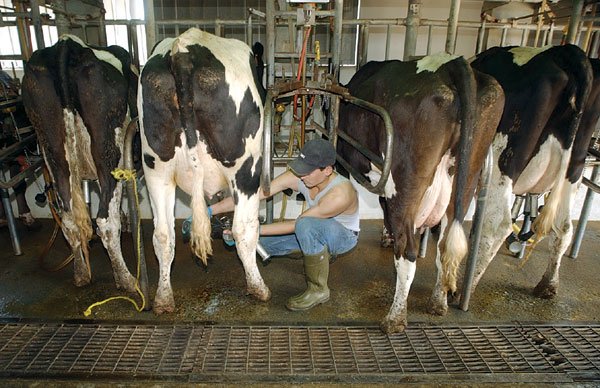Gilroy
– As Santa Clara County prosecutors consider what course of
action to take against Furtado Dairy Farm for a 4.5-mile wastewater
spill, details are emerging about the farm’s spotty history of
environmental compliance.
It appears that last week’s discharge, which dumped 240,000
gallons of manure water into the Alamias Creek east of Gilroy, was
the worst spill in the Dairy’s 41-year history, but not the
first.
Gilroy – As Santa Clara County prosecutors consider what course of action to take against Furtado Dairy Farm for a 4.5-mile wastewater spill, details are emerging about the farm’s spotty history of environmental compliance.
It appears that last week’s discharge, which dumped 240,000 gallons of manure water into the Alamias Creek east of Gilroy, was the worst spill in the Dairy’s 41-year history, but not the first.
“When I inherited it, they had a long standing history of not conducting monitoring of the facility and submitting monitoring reports for water and waste disposal,” Matthew Keeling, an engineer with Central Coast Regional Water Control Board, said. “A history of discharge was what got us involved.”
Deputy District Attorney John Fioretta said Wednesday his office has not yet decided how or whether to charge the dairy’s owner, Manuel Furtado, but Keeling predicted that Furtado is “in for some hurt.”
The regional board took its first action against Furtado Dairy in the early 1980s, when it was operated by Furtado’s uncle, William Furtado. In 1982 and 1983, the board issued cleanup or abatement orders directing Furtado to prevent wastewater from reaching the Alamias, which runs adjacent to the property on Ferguson Road.
At one point, the board referred the matter to the state Attorney General’s office. A report prepared by regional board staff in 1986 states that “although a court order was issued specifying containment of waste and an engineering report, overflow problems continued.”
Water from Furtado’s farm tested for nitrates, chloride, sodium and solids far above levels considered safe in the groundwater. In 1986, the board ordered him to install two monitoring wells, but the dairy ceased operations.
It reopened in 1992, but wells were not installed. It wasn’t until 2000 that the regional board again requested a monitoring report. William Furtado submitted that report, complete with information from two monitoring wells that didn’t actually exist.
When regional board staffers inspected the dairy, they found evidence that cows were allowed to roam in the creek bed and spotted a dead cow decomposing on an access road. They later reported that the animals had been cut off from the creek.
But Furtado continued to ignore repeated requests for monitoring reports. It wasn’t until last year, 18 years after the dairy was originally ordered to install the wells, that Manuel Furtado did so. But not until he was hit with a $5,000 fine.
“The fine was one of the things that got them on the ball as far as installing the wells and filing the reports of discharge,” Keeling said.
Manuel Furtado said Wednesday that he did not install the wells until 2004 because he wasn’t aware of the order until 2003, when he assumed ownership of the dairy from his uncle. He stressed that until last week, the farm hadn’t illegally discharged wastewater since 1992. He said last week’s spill was an accident.
“It’s not like I did it on purpose,” Furtado said. “I didn’t turn my pump on and let it pour into the creek. That was not my intention at all.”
The water, full of cow manure and compounds harmful to fish and humans, traveled 4.5 miles through the Alamias, stopping just short of the Llagas Creek headwaters south of Pacheco Pass Highway. The spill was discovered Thursday afternoon when an anonymous caller tipped off the Santa Clara Valley Water District. Environmental officials said the spill was a danger to the endangered steelhead trout, which migrates through the Llagas, and a potential threat to the groundwater basin.
Keeling said this week that his initial investigation indicates that Furtado was in violation of his discharge permits.
The water in the dairy’s six retention ponds is repeatedly flushed through the dairy to clean manure from the feed barns. In ideal conditions it would evaporate before Furtado is forced to pump it. Furtado is allowed to pump at his discretion into nearby fields but must ensure that none of it reaches state waterways.
He admitted Wednesday that the pump he is supposed to use is broken.
“I will get that done soon,” he said. “I should have the sprinkler fixed in a couple of weeks.” Furtado also pledged to repair a barrier separating his property from residential neighbors on Dunlap Avenue. Those neighbors have complained for years that their yards are overrun with wastewater whenever it rains.
“The odor and stink is terrible,” George Ekberg said last week. “When the rains come they figure they can dump whatever they want to and rain will wash it away. It washes across my property.”
Furtado is facing a variety of civil and criminal penalties, including a year in jail. Keeling said that the regional board will play a supporting role in the DA’s cases against Furtado.
“But we reserve the right to pursue our own enforcement as appropriate and necessary under the law.”













